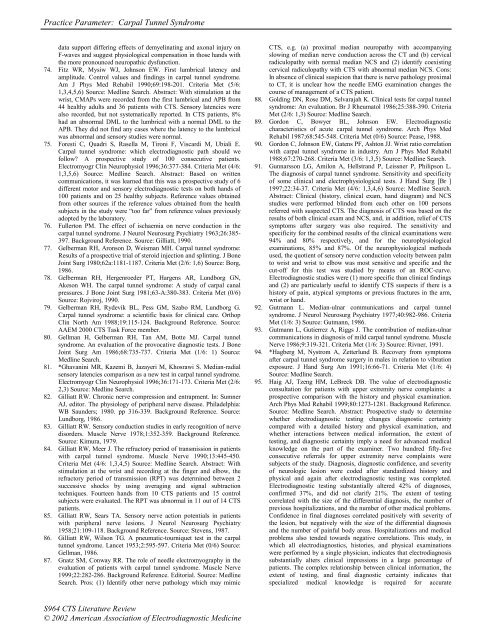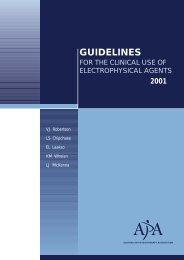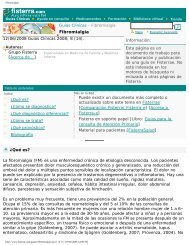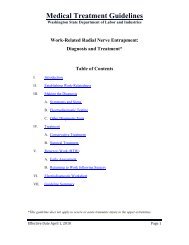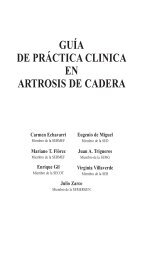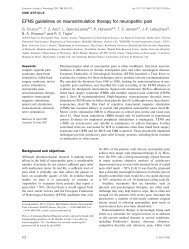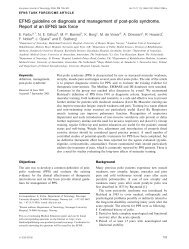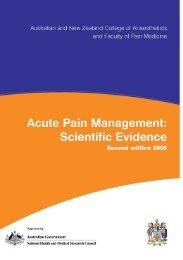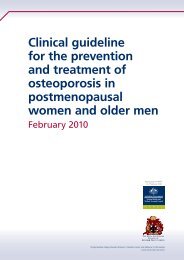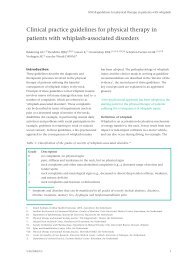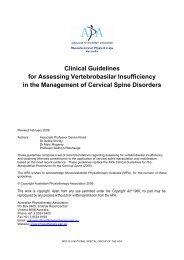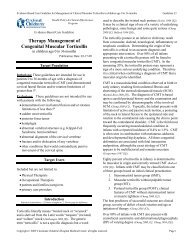Practice Parameter and Literature Review of the Usefulness of ...
Practice Parameter and Literature Review of the Usefulness of ...
Practice Parameter and Literature Review of the Usefulness of ...
Create successful ePaper yourself
Turn your PDF publications into a flip-book with our unique Google optimized e-Paper software.
<strong>Practice</strong> <strong>Parameter</strong>: Carpal Tunnel Syndromedata support differing effects <strong>of</strong> demyelinating <strong>and</strong> axonal injury onF-waves <strong>and</strong> suggest physiological compensation in those h<strong>and</strong>s with<strong>the</strong> more pronounced neuropathic dysfunction.74. Fitz WR, Mysiw WJ, Johnson EW. First lumbrical latency <strong>and</strong>amplitude. Control values <strong>and</strong> findings in carpal tunnel syndrome.Am J Phys Med Rehabil 1990;69:198-201. Criteria Met (5/6:1,3,4,5,6) Source: Medline Search. Abstract: With stimulation at <strong>the</strong>wrist, CMAPs were recorded from <strong>the</strong> first lumbrical <strong>and</strong> APB from44 healthy adults <strong>and</strong> 36 patients with CTS. Sensory latencies werealso recorded, but not systematically reported. In CTS patients, 8%had an abnormal DML to <strong>the</strong> lumbrical with a normal DML to <strong>the</strong>APB. They did not find any cases where <strong>the</strong> latency to <strong>the</strong> lumbricalwas abnormal <strong>and</strong> sensory studies were normal.75. Foresti C, Quadri S, Rasella M, Tironi F, Viscardi M, Ubiali E.Carpal tunnel syndrome: which electrodiagnostic path should wefollow? A prospective study <strong>of</strong> 100 consecutive patients.Electromyogr Clin Neurophysiol 1996;36:377-384. Criteria Met (4/6:1,3,5,6) Source: Medline Search. Abstract: Based on writtencommunications, it was learned that this was a prospective study <strong>of</strong> 6different motor <strong>and</strong> sensory electrodiagnostic tests on both h<strong>and</strong>s <strong>of</strong>100 patients <strong>and</strong> on 25 healthy subjects. Reference values obtainedfrom o<strong>the</strong>r sources if <strong>the</strong> reference values obtained from <strong>the</strong> healthsubjects in <strong>the</strong> study were “too far” from reference values previouslyadopted by <strong>the</strong> laboratory.76. Fullerton PM. The effect <strong>of</strong> ischaemia on nerve conduction in <strong>the</strong>carpal tunnel syndrome. J Neurol Neurosurg Psychiatry 1963;26:385-397. Background Reference. Source: Gilliatt, 1990.77. Gelberman RH, Aronson D, Weisman MH. Carpal tunnel syndrome:Results <strong>of</strong> a prospective trial <strong>of</strong> steroid injection <strong>and</strong> splinting. J BoneJoint Surg 1980;62a:1181-1187. Criteria Met (2/6: 1,6) Source: Borg,1986.78. Gelberman RH, Hergenroeder PT, Hargens AR, Lundborg GN,Akeson WH. The carpal tunnel syndrome: A study <strong>of</strong> carpal canalpressures. J Bone Joint Surg 1981;63-A:380-383. Criteria Met (0/6)Source: Rojviroj, 1990.79. Gelberman RH, Rydevik BL, Pess GM, Szabo RM, Lundborg G.Carpal tunnel syndrome: a scientific basis for clinical care. OrthopClin North Am 1988;19:115-124. Background Reference. Source:AAEM 2000 CTS Task Force member.80. Gellman H, Gelberman RH, Tan AM, Botte MJ. Carpal tunnelsyndrome. An evaluation <strong>of</strong> <strong>the</strong> provocative diagnostic tests. J BoneJoint Surg Am 1986;68:735-737. Criteria Met (1/6: 1) Source:Medline Search.81. *Ghavanini MR, Kazemi B, Jazayeri M, Khosrawi S. Median-radialsensory latencies comparison as a new test in carpal tunnel syndrome.Electromyogr Clin Neurophysiol 1996;36:171-173. Criteria Met (2/6:2,3) Source: Medline Search.82. Gilliatt RW. Chronic nerve compression <strong>and</strong> entrapment. In: SumnerAJ, editor. The physiology <strong>of</strong> peripheral nerve disease. Philadelphia:WB Saunders; 1980. pp 316-339. Background Reference. Source:Lundborg, 1986.83. Gilliatt RW. Sensory conduction studies in early recognition <strong>of</strong> nervedisorders. Muscle Nerve 1978;1:352-359. Background Reference.Source: Kimura, 1979.84. Gilliatt RW, Meer J. The refractory period <strong>of</strong> transmission in patientswith carpal tunnel syndrome. Muscle Nerve 1990;13:445-450.Criteria Met (4/6: 1,3,4,5) Source: Medline Search. Abstract: Withstimulation at <strong>the</strong> wrist <strong>and</strong> recording at <strong>the</strong> finger <strong>and</strong> elbow, <strong>the</strong>refractory period <strong>of</strong> transmission (RPT) was determined between 2successive shocks by using averaging <strong>and</strong> signal subtractiontechniques. Fourteen h<strong>and</strong>s from 10 CTS patients <strong>and</strong> 15 controlsubjects were evaluated. The RPT was abnormal in 11 out <strong>of</strong> 14 CTSpatients.85. Gilliatt RW, Sears TA. Sensory nerve action potentials in patientswith peripheral nerve lesions. J Neurol Neurosurg Psychiatry1958;21:109-118. Background Reference. Source: Stevens, 1987.86. Gilliatt RW, Wilson TG. A pneumatic-tourniquet test in <strong>the</strong> carpaltunnel syndrome. Lancet 1953;2:595-597. Criteria Met (0/6) Source:Gellman, 1986.87. Gnatz SM, Conway RR. The role <strong>of</strong> needle electromyography in <strong>the</strong>evaluation <strong>of</strong> patients with carpal tunnel syndrome. Muscle Nerve1999;22:282-286. Background Reference. Editorial. Source: MedlineSearch. Pros: (1) Identify o<strong>the</strong>r nerve pathology which may mimicCTS, e.g. (a) proximal median neuropathy with accompanyingslowing <strong>of</strong> median nerve conduction across <strong>the</strong> CT <strong>and</strong> (b) cervicalradiculopathy with normal median NCS <strong>and</strong> (2) identify coexistingcervical radiculopathy with CTS with abnormal median NCS. Cons:In absence <strong>of</strong> clinical suspicion that <strong>the</strong>re is nerve pathology proximalto CT, it is unclear how <strong>the</strong> needle EMG examination changes <strong>the</strong>course <strong>of</strong> management <strong>of</strong> a CTS patient.88. Golding DN, Rose DM, Selvarajah K. Clinical tests for carpal tunnelsyndrome: An evaluation. Br J Rheumatol 1986;25:388-390. CriteriaMet (2/6: 1,3) Source: Medline Search.89. Gordon C, Bowyer BL, Johnson EW. Electrodiagnosticcharacteristics <strong>of</strong> acute carpal tunnel syndrome. Arch Phys MedRehabil 1987;68:545-548. Criteria Met (0/6) Source: Pease, 1988.90. Gordon C, Johnson EW, Gatens PF, Ashton JJ. Wrist ratio correlationwith carpal tunnel syndrome in industry. Am J Phys Med Rehabil1988;67:270-268. Criteria Met (3/6: 1,3,5) Source: Medline Search.91. Gunnarsson LG, Amilon A, Hellstr<strong>and</strong> P, Leissner P, Philipson L.The diagnosis <strong>of</strong> carpal tunnel syndrome. Sensitivity <strong>and</strong> specificity<strong>of</strong> some clinical <strong>and</strong> electrophysiological tests. J H<strong>and</strong> Surg [Br ]1997;22:34-37. Criteria Met (4/6: 1,3,4,6) Source: Medline Search.Abstract: Clinical (history, clinical exam, h<strong>and</strong> diagram) <strong>and</strong> NCSstudies were performed blinded from each o<strong>the</strong>r on 100 personsreferred with suspected CTS. The diagnosis <strong>of</strong> CTS was based on <strong>the</strong>results <strong>of</strong> both clinical exam <strong>and</strong> NCS, <strong>and</strong>, in addition, relief <strong>of</strong> CTSsymptoms after surgery was also required. The sensitivity <strong>and</strong>specificity for <strong>the</strong> combined results <strong>of</strong> <strong>the</strong> clinical examinations were94% <strong>and</strong> 80% respectively, <strong>and</strong> for <strong>the</strong> neurophysiologicalexaminations, 85% <strong>and</strong> 87%. Of <strong>the</strong> neurophysiological methodsused, <strong>the</strong> quotient <strong>of</strong> sensory nerve conduction velocity between palmto wrist <strong>and</strong> wrist to elbow was most sensitive <strong>and</strong> specific <strong>and</strong> <strong>the</strong>cut-<strong>of</strong>f for this test was studied by means <strong>of</strong> an ROC-curve.Electrodiagnostic studies were (1) more specific than clinical findings<strong>and</strong> (2) are particularly useful to identify CTS suspects if <strong>the</strong>re is ahistory <strong>of</strong> pain, atypical symptoms or previous fractures in <strong>the</strong> arm,wrist or h<strong>and</strong>.92. Gutmann L. Median-ulnar communications <strong>and</strong> carpal tunnelsyndrome. J Neurol Neurosurg Psychiatry 1977;40:982-986. CriteriaMet (1/6: 3) Source: Gutmann, 1986.93. Gutmann L, Gutierrez A, Riggs J. The contribution <strong>of</strong> median-ulnarcommunications in diagnosis <strong>of</strong> mild carpal tunnel syndrome. MuscleNerve 1986;9:319-321. Criteria Met (1/6: 3) Source: Rivner, 1991.94. *Hagberg M, Nystrom A, Zetterlund B. Recovery from symptomsafter carpal tunnel syndrome surgery in males in relation to vibrationexposure. J H<strong>and</strong> Surg Am 1991;16:66-71. Criteria Met (1/6: 4)Source: Medline Search.95. Haig AJ, Tzeng HM, LeBreck DB. The value <strong>of</strong> electrodiagnosticconsultation for patients with upper extremity nerve complaints: aprospective comparison with <strong>the</strong> history <strong>and</strong> physical examination.Arch Phys Med Rehabil 1999;80:1273-1281. Background Reference.Source: Medline Search. Abstract: Prospective study to determinewhe<strong>the</strong>r electrodiagnostic testing changes diagnostic certaintycompared with a detailed history <strong>and</strong> physical examination, <strong>and</strong>whe<strong>the</strong>r interactions between medical information, <strong>the</strong> extent <strong>of</strong>testing, <strong>and</strong> diagnostic certainty imply a need for advanced medicalknowledge on <strong>the</strong> part <strong>of</strong> <strong>the</strong> examiner. Two hundred fifty-fiveconsecutive referrals for upper extremity nerve complaints weresubjects <strong>of</strong> <strong>the</strong> study. Diagnosis, diagnostic confidence, <strong>and</strong> severity<strong>of</strong> neurologic lesion were coded after st<strong>and</strong>ardized history <strong>and</strong>physical <strong>and</strong> again after electrodiagnostic testing was completed.Electrodiagnostic testing substantially altered 42% <strong>of</strong> diagnoses,confirmed 37%, <strong>and</strong> did not clarify 21%. The extent <strong>of</strong> testingcorrelated with <strong>the</strong> size <strong>of</strong> <strong>the</strong> differential diagnosis, <strong>the</strong> number <strong>of</strong>previous hospitalizations, <strong>and</strong> <strong>the</strong> number <strong>of</strong> o<strong>the</strong>r medical problems.Confidence in final diagnoses correlated positively with severity <strong>of</strong><strong>the</strong> lesion, but negatively with <strong>the</strong> size <strong>of</strong> <strong>the</strong> differential diagnosis<strong>and</strong> <strong>the</strong> number <strong>of</strong> painful body areas. Hospitalizations <strong>and</strong> medicalproblems also tended towards negative correlations. This study, inwhich all electrodiagnostics, histories, <strong>and</strong> physical examinationswere performed by a single physician, indicates that electrodiagnosissubstantially alters clinical impressions in a large percentage <strong>of</strong>patients. The complex relationship between clinical information, <strong>the</strong>extent <strong>of</strong> testing, <strong>and</strong> final diagnostic certainty indicates thatspecialized medical knowledge is required for accurateS964 CTS <strong>Literature</strong> <strong>Review</strong>© 2002 American Association <strong>of</strong> Electrodiagnostic Medicine


